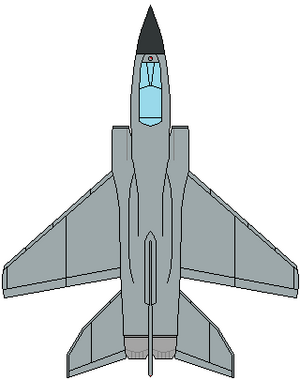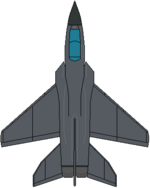Ahuriri Aerospace Whaitiri Kāhu: Difference between revisions
| Line 68: | Line 68: | ||
==Gallery== | ==Gallery== | ||
[[File:WK.8.png|150px|Proposed Whaitiri Kāhu | [[File:WK.8.png|150px|Proposed Whaitiri Kāhu FSR.8]] | ||
==See also== | ==See also== | ||
'''Aircraft of comparable role and era''' | '''Aircraft of comparable role and era''' | ||
Revision as of 10:26, 3 August 2021
This article is incomplete because it is pending further input from participants, or it is a work-in-progress by one author. Please comment on this article's talk page to share your input, comments and questions. Note: To contribute to this article, you may need to seek help from the author(s) of this page. |
| Ahuriri Aerospace Whaitiri Kāhu | |
|---|---|

| |
| Whaitiri Kāhu FS.7 | |
| Role | Multirole Fighter |
| Manufacturer | Ahuriri Aerospace |
| First flight | 1986 |
| Introduction | 1991 |
| Primary user | Royal Onekawa-Nukanoa Air Force Royal Onekawa-Nukanoa Navy |
The Ahuriri Aerospace Whaitiri Kāhu (English: Thunder Harrier) is an Onekawan multirole fighter designed and manufacutred by Ahuriri Aerospace. It first saw service with the Royal Onekawa-Nukanoa Air Force in 1991 with a naval variant following in 1992 for the Royal Onekawa-Nukanoa Navy. Serving as a replacement for the Ahuriri Aerospace Kērangi and to supplement the Arthuristan Dynamics/Ahuriri Aerospace Cyclone, the Whaitiri Kāhu is a medium-sized, twin-engine single/two-seat aircraft that has been manufactured in a four major variants, including the navalised version and a dedicated variant for the electronic warfare role. During its service life the Whaitiri Kāhu has undergone a number of upgrade programs and developments that enhanced it's capabilities in both the aerial and ground strike roles.
Development
Origins
In the early 1980s, the RONAF and RONN operated two principal combat aircraft, the Arthuristan Dynamics/Ahuriri Aerospace Cyclone served as the principal air superiority platform whilst the older Ahuriri Aerospace Kērangi was at this point primary ground attack and strike aircraft, with additional variants focused on reconnaissance and electronic warfare roles. However the performance of the first generation of Cyclone]] engines was notably lacking and there had been issues with reliability and readiness rates.
The Kērangi issues were of greater concern, the increasing age of the fleet had resulted in a number of issues, most notably such as increasingly poor reliability and availability rates. To address these issues in the short term the Kērangi would undertake a significant upgrade program; whilst more long-term plans would include the development of the improved Cyclone FGR.2 and finally the development of a total replacement for the Kērangi that could also be of successful on the export market.
Design
The Whaitiri Kāhu is a multirole, twin-engine single or dual seat fighter aircraft designed to be equally capable of engaging aerial and ground targets. Intended to be a replacement for the Ahuriri Aerospace Kērangi for both the Royal Onekawa-Nukanoa Air Force and Royal Onekawa-Nukanoa Navy, the navalised Whaitiri Kāhu has a notably more robust airframe and undercarriage, and is designed to be resistant too saltwater corrosion with the addition of an arrestor hook. Because of this the navalised variant is heavier, and has correspondingly decreased performance compared to the regular lighter air force aircraft.
Whaitiri Kāhu are equipped with two AA Henaki 650 afterburning turbofans which allowed. These new engines developed specifically for the Whaitiri Kāhu alongside considerable internal space for fuel allow a combat range of 1,400km with an dedicated air combat load, as well as significantly more on-station liter time in comparison to its predecessors through improved fuel efficiency at subsonic speeds as a result of the use of more advanced composite materials and design improvements in the AA Henaki 650 engines. This already significant combat range would be improved to 1,690km with the inclusion of conformal fuel tanks in the FS.5 and ER.3 versions or through the carriage of regular fuel tanks. It also showed significant performance, with Whaitiri Kāhu able to reach mach 2.2 with a full combat load.
Variants
Whaitiri Kāhu FS.1 to FS.4
Early generations of the Whaitiri Kāhu generally only underwent minor improvements between models. The FS.2 differed from the original predecessors when excessive micro-cracks started to appear after only 2,000 flight hours on some of the canopies on aircraft in the fleet; particularly after prolonged hi-g maneuvers. As a pre-emptive measure, all canopies would be replaced and the problem was identified to be a an error with the manufacturing tolerances in one of Ahuriri Aerospaces subcontractors. This was quickly followed by the FS.3, which was the most significant update amongst the early generation when the original 9 hardpoints was increased to 10 with a allow the inclusion of an additional centreline pylon, as well as the strengthen off all pylons; although this did not improve the total munitions capacity.
The final update to the FS.4 would be the inclusion of a helmet-mounted sight in the form of the Yisraeli DASH system as had been introduced in the Cyclone FSR.2 over the use of the more traditional HUD; allowing improved combability with the Python missile. Such a capability had been planned for the original launch version of the aircraft, but budgetary pressure pushed back it's introduction.
Whaitiri Kāhu FSR.5 to FSR.7
The FSR.5 was a major update of the design of the Whaitiri Kāhu. Whilst a number would be re-built former models, many FSR.5 aircraft were new-builds and received a broad range of improvements over the prior FS.4. The most distinct change visually would be the ability to carry of two conformal fuel tanks on the upperside of the fuselage. The CFTs greatly improved range and loiter time whilst with adding the noteworthy aerodynamic penalties associated with regular drop tanks whilst also opening up the aircrafts hardpoints for the carriage of more munitions or equipment.
These would also be a reinvention of the cockpit, with the prior central CRT monitor being replaced with a new LCD touchscreen primary interface and allowed for the removal of a number of the prior dials and switches associated with the management of various systems to the new digital interface. Other major upgrades include the addititon of a new automatic self-defence management system.
EWhaitiri Kāhu ER.1 to ER.4
Whaitiri Kāhu FSR.8
Service
Accidents
Specifications (Whaitiri Kāhu FSR.7)
- Crew: 1/2
- Engines: 2 x AA Henaki 650 afterburning turbofans, each producing 13,000lbf (57.82 kN) and 22,500 lbf (100.08 kN) with afterburner.
- Wingspan: 14.45m
- Length: 17.18m
- Height: 5.95m
- Empty Weight: 12,900kgs
- Top Speed: Mach 2.2
- Ceiling: 48,500 ft
- Combat Range: 1,690km
- Sensors: OSVA RR.310 Radar
- Armaments: 1 x 20mm rotary cannon, 10 total hardpoints: 6 x under-wing, 4 x centreline pylons with total capacity for 8,500kgs of munitions
Gallery
See also
Aircraft of comparable role and era


